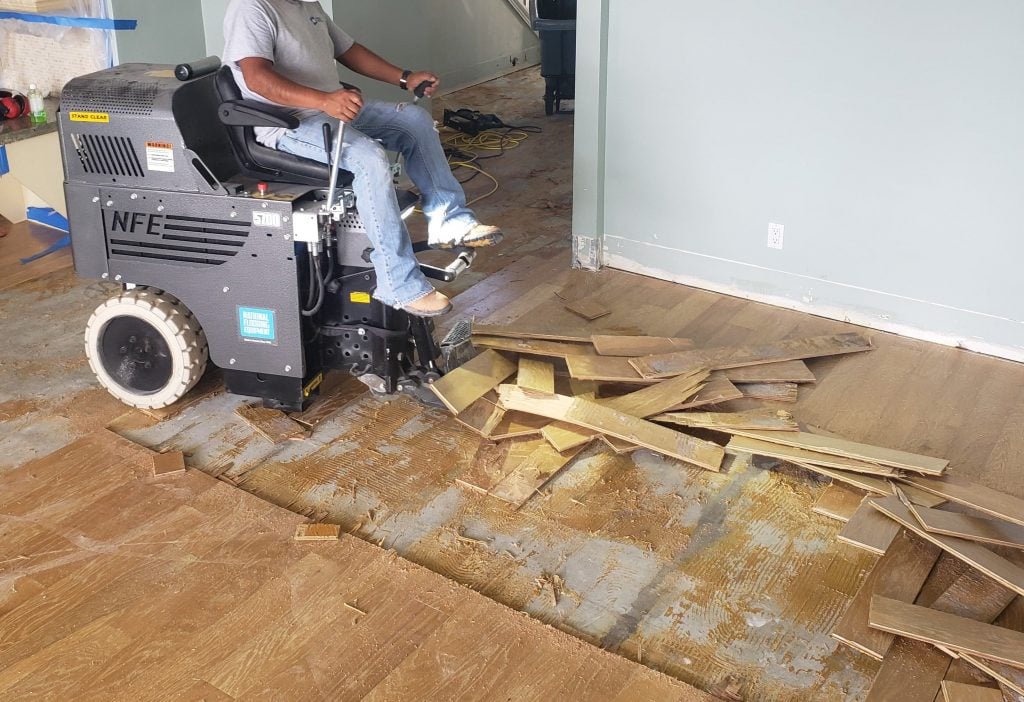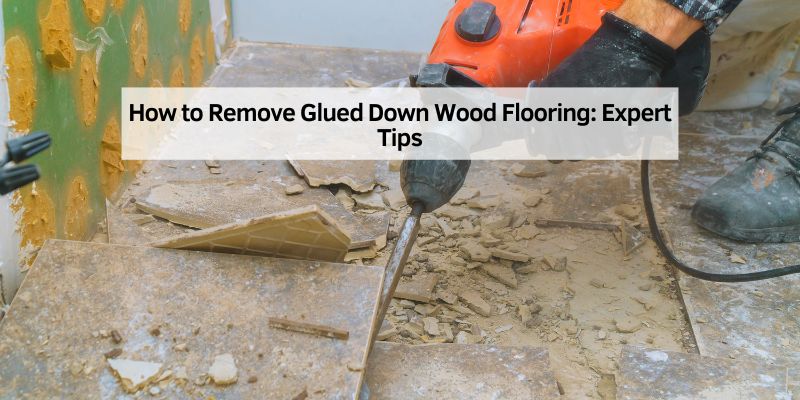Removing glued down wood flooring can be tricky. But it’s doable with the right steps.
This task might seem daunting at first, but with some guidance, it becomes manageable. Glued wood floors are known for their durability and sturdiness. Yet, when it’s time for a change, they can pose a challenge. Understanding the process is key to making it easier.
Preparation is crucial for success. You need the right tools and a clear plan. Knowing the type of adhesive used can also make a big difference. Safety is another important factor. Protecting yourself and your home is essential during the removal process. This guide will help you understand each step. From preparation to the final cleanup, we’ll cover everything you need to know. Get ready to tackle this project with confidence.
Preparation Steps
Removing glued wood flooring needs proper tools. Gather a pry bar, hammer, and chisel. You will need a floor scraper too. Have a vacuum cleaner ready for dust. Wear gloves for protection. Keep a dust mask handy. Safety goggles are important. Clear the room of all furniture. This keeps the area safe and open. Check for nails and screws. Remove them before starting. Prepare well to make the task easy.
Safety is first. Wear gloves to protect your hands. Use a dust mask to breathe clean air. Safety goggles protect your eyes from debris. Make sure the area is clear of obstacles. Check for nails sticking out. Remove them to avoid injury. Keep tools organized and close by. Take breaks to stay safe and alert. Follow these steps for a safe removal process.

Credit: www.reddit.com
Assessing Floor Condition
First, find out what type of wood flooring you have. Is it solid wood or engineered wood? Solid wood is thicker and stronger. Engineered wood has layers and is lighter. Both need different tools for removal. Knowing the type helps in choosing the right method.
Glued floors use different kinds of adhesive. Some are soft; others are hard. Soft adhesives are easier to remove. Hard adhesives need more effort and tools. Try to find the type by looking at the edges. This helps in planning the removal work.
Choosing Removal Method
Removing glued wood floor can be tough. Start by using a chisel. Insert it under the wood. Lift the wood slowly. This method needs patience. Use a hammer to tap the chisel. Be careful not to hurt yourself. Wear gloves for safety. A pry bar can help too. Slide it under the wood. Pull up to remove the wood. This way works well for small areas. Repeat until all wood is removed.
Power tools make work easier. A floor scraper is useful. It has a sharp blade. Plug it in to start. Press the blade under the wood. The tool will shake and loosen the wood. Move it slowly across the floor. Vacuum the dust after. Saw tools can help too. They cut the wood faster. Be careful with saws. Wear goggles to protect your eyes. Follow instructions on tools carefully.
Manual Removal Process
A pry bar can help lift the wood. Start at the corner. Insert the pry bar under the wood. Apply pressure to lift the wood. Work slowly to avoid damage. Move along the edges. Force may be needed for stubborn areas. Wear gloves for safety. Be cautious of splinters. Ensure proper grip on the tool. Secure the wood before lifting it.
A saw can cut the wood into manageable pieces. Begin by marking sections. Use a saw to cut along the marks. Smaller pieces are easier to remove. Check for nails and obstacles. Always wear safety glasses. Handle the saw carefully. Dispose of wood pieces properly. Clean the area after cutting. Ensure the floor is smooth before new installation.
Power Tool Removal Techniques
A floor scraper is a useful tool for removing glued wood. It can save time and effort. Start by setting the scraper at a low angle. This helps to get under the wood. Push the scraper forward with steady hands. Apply pressure to peel the wood from the floor. Be cautious not to damage the subfloor. If the wood is stubborn, a power scraper might be needed. Always wear safety gear to protect yourself.
Heat guns can soften glue for easier removal. Begin by heating a small section of the floor. Keep the gun moving to avoid burns. Once the glue softens, use a scraper to lift the wood. Work in small sections to manage the process. Heat can make glue sticky and easier to remove. Safety is important. Wear gloves and goggles. Avoid overheating the wood.

Credit: jblflooringsolutions.com
Dealing With Adhesive Residue
Removing glue from wood needs care. Chemical solvents help break the residue. Apply the solvent with a clean cloth. Let it sit for a while. Check if the glue softens. Use a scraper gently to lift the glue. Be careful not to harm the wood. Repeat as needed. Ventilate the room well. Solvent fumes can be strong.
Scraping is another way to remove glue. Use a putty knife or scraper. Hold the tool at an angle. Push against the glue carefully. Take breaks to check progress. Wood can get scratched easily. Be gentle and patient. Work in small sections. Clean the area after scraping. Dust and debris can hide glue spots.
Handling Difficult Areas
Removing glued down wood flooring can be a tough task. Start by loosening the edges with a pry bar. Use a heat gun to soften the glue, making it easier to peel away the planks. Work slowly to avoid damaging the subfloor.
Corners And Edges
Removing wood from corners can be tricky. Use a small pry bar for tight spaces. Tap lightly with a hammer. Be patient. Carefully lift the wood. Avoid damaging the wall. A chisel might help for stubborn spots. Work slowly to prevent errors. If a corner is too tight, adjust your angle. Use a utility knife for stubborn glue.
Around Obstacles
Wood flooring around pipes or vents needs care. Use a jigsaw for curves. Protect nearby objects with cloth. Avoid scratching them. Slow and steady is best. For narrow areas, a multi-tool can be helpful. Try different blades for varying tasks. Remove any nails or screws first. If glue is thick, apply a solvent. Wait for a few minutes. Then, gently scrape the surface.
Cleanup And Disposal
Removing glued down wood flooring involves careful planning and execution. Start by cutting the flooring into manageable sections. Use a scraper or pry bar to lift the wood, ensuring minimal damage to the subfloor. Dispose of the debris responsibly.
Removing Debris
Wear gloves to keep your hands safe. Use a broom to gather the pieces. Sweep up all the wood bits. Be careful with sharp edges. They can cut you. Place the wood bits into a strong bag. Make sure the bag is not too heavy. Use a vacuum to clean small pieces. The floor must be clean before the next step.
Disposing Of Materials Properly
Find out where to take the wood. Some places recycle wood. Ask your local waste center for help. Do not throw wood in the regular trash. It might not be safe. Check the rules in your area. Follow them to avoid problems. Some wood has chemicals. These need special disposal. Be responsible and protect the environment.
Post-removal Inspection
Inspect the floor thoroughly after removing glued-down wood flooring. Look for leftover adhesive or damage to the subfloor. Ensure all pieces are removed before proceeding with repairs or new installation.
Check Subfloor Condition
Inspect the subfloor after removing the glued wood flooring. Look for any damage or signs of moisture. A clean and dry subfloor is important. If there are any nails or staples, remove them carefully. A smooth surface helps the new flooring stick well.
Prepare For New Flooring
Make sure the subfloor is level. Use a level tool to check for any bumps. Sand down high spots if needed. Fill low areas with floor patch compound. Let the compound dry before installing new flooring. Vacuum the area to remove dust and debris. A clean subfloor ensures a good start for your new floor.

Credit: www.reddit.com
Frequently Asked Questions
How Do You Remove Glued Down Hardwood Flooring?
To remove glued down hardwood flooring, use a pry bar and hammer to lift the planks. Apply adhesive remover to dissolve glue residues. Work slowly to avoid damaging the subfloor. Wear protective gear for safety. Dispose of materials responsibly.
How Do You Remove Glued Down Plank Flooring?
To remove glued plank flooring, soften adhesive using a heat gun. Pry planks using a floor scraper or crowbar. Remove residual glue with a solvent or adhesive remover. Ensure proper ventilation during removal. Wear protective gear for safety.
What Is The Best Tool To Remove Glue Down Flooring?
The best tool to remove glue down flooring is a floor scraper with a sharp blade. Consider using a heat gun to soften adhesive. For larger areas, rent a power scraper for efficient removal. Always wear protective gear and follow safety guidelines during the process.
What Dissolves Wood Floor Glue?
Acetone or mineral spirits effectively dissolve wood floor glue. Apply a small amount and gently scrub the residue. Ensure proper ventilation and test on a hidden area first to avoid damage. Always use protective gear like gloves and goggles to safeguard your skin and eyes during the process.
Conclusion
Removing glued down wood flooring can be challenging. With the right tools, it becomes manageable. Remember to work in small sections. This makes the task easier. Safety should always come first. Wear protective gear like gloves and goggles. Take your time to avoid damaging the subfloor.
Patience is key during this process. Dispose of old flooring responsibly. Consider recycling options if available. Following these steps ensures a smoother removal. Your floor will be ready for a fresh start. Enjoy your new flooring installation project. You’ll appreciate the effort once it’s complete.

